翻译研究方法Research Proposal
research proposal的特点
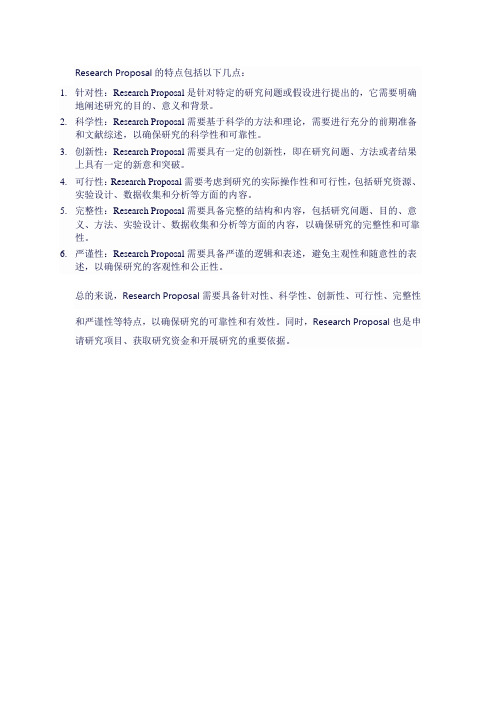
Research Proposal的特点包括以下几点:
1.针对性:Research Proposal是针对特定的研究问题或假设进行提出的,它需要明确
地阐述研究的目的、意义和背景。
2.科学性:Research Proposal需要基于科学的方法和理论,需要进行充分的前期准备
和文献综述,以确保研究的科学性和可靠性。
3.创新性:Research Proposal需要具有一定的创新性,即在研究问题、方法或者结果
上具有一定的新意和突破。
4.可行性:Research Proposal需要考虑到研究的实际操作性和可行性,包括研究资源、
实验设计、数据收集和分析等方面的内容。
5.完整性:Research Proposal需要具备完整的结构和内容,包括研究问题、目的、意
义、方法、实验设计、数据收集和分析等方面的内容,以确保研究的完整性和可靠性。
6.严谨性:Research Proposal需要具备严谨的逻辑和表述,避免主观性和随意性的表
述,以确保研究的客观性和公正性。
总的来说,Research Proposal需要具备针对性、科学性、创新性、可行性、完整性和严谨性等特点,以确保研究的可靠性和有效性。
同时,Research Proposal也是申请研究项目、获取研究资金和开展研究的重要依据。
英文research proposal
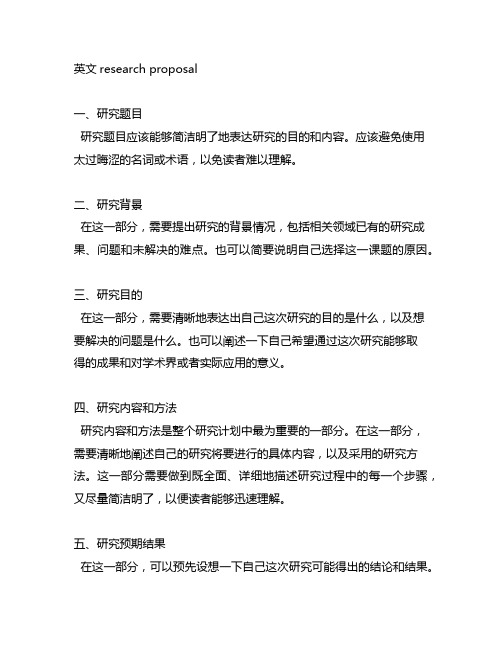
英文research proposal一、研究题目研究题目应该能够简洁明了地表达研究的目的和内容。
应该避免使用太过晦涩的名词或术语,以免读者难以理解。
二、研究背景在这一部分,需要提出研究的背景情况,包括相关领域已有的研究成果、问题和未解决的难点。
也可以简要说明自己选择这一课题的原因。
三、研究目的在这一部分,需要清晰地表达出自己这次研究的目的是什么,以及想要解决的问题是什么。
也可以阐述一下自己希望通过这次研究能够取得的成果和对学术界或者实际应用的意义。
四、研究内容和方法研究内容和方法是整个研究计划中最为重要的一部分。
在这一部分,需要清晰地阐述自己的研究将要进行的具体内容,以及采用的研究方法。
这一部分需要做到既全面、详细地描述研究过程中的每一个步骤,又尽量简洁明了,以便读者能够迅速理解。
五、研究预期结果在这一部分,可以预先设想一下自己这次研究可能得出的结论和结果。
也可以说明一下如果研究取得了预期的成果,对学术研究或者实际应用将会有怎样的帮助。
六、研究进度安排在这一部分,需要列出自己的研究进度安排,包括每个阶段具体需要做的工作内容、预计需要的时间,在研究过程中可能遇到的困难和问题以及相应的解决办法。
七、参考文献研究过程中所使用的参考文献应当列举清楚,并且按照一定的格式规范进行标注,以便审阅者查阅参考。
以上便是一份较为完整的英文research proposal的写作要点。
编写一份高质量的research proposal需要作者全面理解自己的研究内容,并清晰地向读者传达出来。
也需要遵循一定的格式规范,以便读者能够迅速理解并审阅。
希望以上内容对您有所帮助。
研究背景在研究背景部分,我将进一步详细介绍所选择的研究领域和当前的研究状况。
我们知道,现代社会信息爆炸,大数据时代已经到来。
在这个背景下,信息检索和数据挖掘变得尤为重要。
随着人工智能和机器学习等技术的飞速发展,自然语言处理也逐渐成为了研究的热点之一。
然而,当前自然语言处理领域依然存在着许多挑战和问题,比如语义理解、语言生成等方面的困难。
research proposal字数

Research Proposal一、研究背景随着社会的发展和进步,科学技术得到了快速发展,人们对科学知识的渴望也越来越强烈。
作为一个研究人员,我们需要不断地深入研究各种领域的知识,为社会的发展做出贡献。
本课题选择了XXX为研究对象,主要是因为XXX有着广阔的研究空间,同时具有一定的实际应用价值。
二、研究目的我们的研究旨在探索XXX的XXX特性,并通过对XXX的深入研究,为XXX领域的发展做出贡献。
通过我们的研究,还可以为企业的XXX 提供一定的参考和指导。
三、研究方法为了达到以上研究目的,我们将采用XXX方法进行研究。
我们将通过实地调查、统计分析、专家访谈等方法,收集大量的XXX相关数据,并对这些数据进行深入、系统的分析和研究,从而揭示XXX的内在特性和规律。
四、研究内容1. XXX的定义和特性我们将通过文献综述和实地调查,对XXX的定义和特性进行界定和分析,从而深入探讨XXX的本质属性。
2. XXX的发展现状及问题我们将通过对XXX的发展现状进行调查和分析,发现其中存在的问题和矛盾,为我们进一步的研究提供依据。
3. XXX的发展趋势通过对XXX的发展趋势进行分析和研究,探讨XXX未来的发展方向和发展空间,为XXX领域的进一步研究提供参考。
五、研究意义我们的研究将有以下意义:1. 为XXX领域的发展提供理论指导和参考;2. 为企业的XXX提供决策支持和指导;3. 为相关研究人员提供研究思路和方法。
六、研究预期成果通过我们的研究,我们希望能够得到以下预期成果:1. 对XXX的定义和特性有更深刻、更系统的认识;2. 对XXX的发展现状、问题和趋势进行了深入的分析和探讨;3. 对XXX领域的发展提出了一定的见解和建议。
七、研究进度安排我们的研究将按以下进度安排进行:1. 月份:进行XXX的文献综述和调研;2. 月份:完成对XXX的实地调查和数据收集;3. 月份:进行数据分析和研究;4. 月份:撰写研究报告和论文。
研究计划 Research roposal

每个学术研究者必须经历的一道关卡,就是Research Proposal的写作。
它大致对应中文里的“开题报告”、“选题报告”、“研究报告”,是一项研究开始之前的提纲、规划和陈述;既是为了帮助自己梳理文献、整理思路、廓清方向,也常常是写给相关他人的说明:研究动机和意义何在?可能有何成果?为什么它值得你的资助/认可/支持/批准?不知道是否可以说,好的proposal是研究成功的一半。
但实际而功利的说,如果你的proposal很烂,可能根本就不会有开始研究的机会。
?How to write a research proposal?能否写出漂亮的proposal,本质上取决于你对研究的思考深度和专业水准。
但形式也很重要。
英文的Research Proposal自有一套“八股”。
程式化和结构化的好处就在于,可以让读者直接集中注意到最本质的内容上,而不是为形式分神。
对于非英语native speaker的我们,如何理解英文学术世界的规范或曰思维定势,也是写作proposal之前必备的背景知识。
下面这篇流传甚广的Research Proposal写作指南,言简意赅,颇具启发,对我自己的写作有所帮助,也希望能给更多的学界同仁带来便利。
[点击这里,查看更多关于RESEARCH PROPOSAL以及GRANT PROPOSAL、PROJECT PROPOSAL写作的网上资源]?文章作者Paul T. P. Wong, Ph.D., C.Psych. (Research Director, Graduate Program in Counselling Psychology. Trinity Western University Langley, BC, Canada). 题为:How to Write a Research Proposal. 全文转载如下:?Most students and beginning researchers do not fully understand what a research proposal means, nor do they understand its importance. To put it bluntly, one’s research is only as a good as one’s proposal. An ill-conceived proposal dooms the project even if it somehowgets through the Thesis Supervisory Committee. A highquality proposal, on the other hand, not only promises success for the project, but also impresses your Thesis Committee about your potential as a researcher.?A research proposal is intended to convince others that you have a worthwhile research project and that you have the competence and the work-plan to complete it. Generally, a research proposal should contain all the key elements involved in the research process and include sufficient information for the readers to evaluate the proposed study.?Regardless of your research area and the methodology you choose, all research proposals must address the following questions: What you plan to accomplish, why you want to doit and how you are going to do it.?The proposal should have sufficient information to convince your readers that you have an important research idea, that you have a good grasp of the relevant literature and the major issues, and that your methodology is sound.?The quality of your research proposal depends not only onthe quality of your proposed project, but also on thequality of your proposal writing. A good research project may run the risk of rejection simply because the proposal is poorly written. Therefore, it pays if your writing is coherent, clear and compelling.?This paper focuses on proposal writing rather than on the development of research ideas.?TITLE:?It should be concise and descriptive. For example, the phrase, “An investigation of . . .” could be omitted. Often titles are stated in terms of a functional relationship, because such titles clearly indicate the independent and dependent variables. However, if possible, think of an informative but catchy title. An effectivet itle not only pricks the reader’s interest, but also predisposes him/her favourably towards the proposal.?ABSTRACT:?It is a brief summary of approximately 300 words. It should include the research question, the rationale for the study, the hypothesis (if any), the method and the main findings. Descriptions of the method may include the design, procedures, the sample and any instruments that will be used.?INTRODUCTION:?The main purpose of the introduction is to provide the necessary background or context for your research problem. How to frame the research problem is perhaps the biggest problem in proposal writing.?If the research problem is framed in the context of a general, rambling literature review, then the research question may appear trivial and uninteresting. However, if the same question is placed in the context of a very focused and current research area, its significance will become evident.?Unfortunately, there are no hard and fast rules on how to frame your research question just as there is no prescription on how to write an interesting and informative opening paragraph. A lot depends on your creativity, your ability to think clearly and the depth of your understanding of problem areas.?However, try to place your research question in the context of either a current “hot” area, or an older area that remains viable. Secondly, you need to provide a brief but appropriate historical backdrop. Thirdly, provide the contemporary context in which your proposed research question occupies the central stage. Finally, identify“key players” and refer to the most relevant and representative publications. In short, try to paint your research question in broad brushes and at the same time bring out its significance.?The introduction typically begins with a general statement of the problem area, with a focus on a specific research problem, to be followed by the rational or justificationfor the proposed study. The introduction generally covers the following elements:?1. State the research problem, which is often referred to as the purpose of the study.?2. Provide the context and set the stage for your research question in such a way as to show its necessity and importance.?3. Present the rationale of your proposed study and clearly indicate why it is worth doing.?4. Briefly describe the major issues and sub-problems to be addressed by your research.?5. Identify the key independent and dependent variables of your experiment. Alternatively, specify the phenomenon you want to study.?6. State your hypothesis or theory, if any. For exploratory or phenomenological research, you may not have any hypotheses. (Please do not confuse the hypothesis with the statistical null hypothesis.)?7. Set the delimitation or boundaries of your proposed research in order to provide a clear focus.?8. Provide definitions of key concepts. (This is optional.)? LITERATURE REVIEW:?Sometimes the literature review is incorporated into the introduction section. However, most professors prefer a separate section, which allows a more thorough review ofthe literature.?The literature review serves several important functions:?1. Ensures that you are not “reinventing the wheel”.?2. Gives credits to those who have laid the groundwork for your research.?3. Demonstrates your knowledge of the research problem.?4. Demonstrates your understanding of the theoretical and research issues related to your research question.?5. Shows your ability to critically evaluate relevant literature information.?6. Indicates your ability to integrate and synthesize the existing literature.?7. Provides new theoretical insights or develops a new model as the conceptual framework for your research.?8. Convinces your reader that your proposed research will make a significant and substantial contribution to the literature (i.e., resolving an important theoretical issue or filling a major gap in the literature).?Most students’ literature reviews suffer from thefollowing problems:?* Lacking organization and structure?* Lacking focus, unity and coherence?* Being repetitive and verbose?* Failing to cite influential papers?* Failing to keep up with recent developments?* Failing to critically evaluate cited papers?* Citing irrelevant or trivial references?* Depending too much on secondary sources?Your scholarship and research competence will be questioned if any of the above applies to your proposal.?There are different ways to organize your literature review. Make use of subheadings to bring order and coherence toyour review. For example, having established the importance of your research area and its current state of development, you may devote several subsections on related issues as: theoretical models, measuring instruments, cross-cultural and gender differences, etc.?It is also helpful to keep in mind that you are telling a story to an audience. Try to tell it in a stimulating and engaging manner. Do not bore them, because it may lead to rejection of your worthy proposal. (Remember: Professorsand scientists are human beings too.)?METHODS:?The Method section is very important because it tells your Research Committee how you plan to tackle your research problem. It will provide your work plan and describe the activities necessary for the completion of your project.?The guiding principle for writing the Method section isthat it should contain sufficient information for thereader to determine whether methodology is sound. Some even argue that a good proposal should contain sufficientdetails for another qualified researcher to implement the study.?You need to demonstrate your knowledge of alternative methods and make the case that your approach is the most appropriate and most valid way to address your research question.?Please note that your research question may be best answered by qualitative research. However, since most mainstream psychologists are still biased against qualitative research, especially the phenomenological variety, you may need to justify your qualitative method.?Furthermore, since there are no well-established and widely accepted canons in qualitative analysis, your method section needs to be more elaborate than what is requiredfor traditional quantitative research. More importantly, the data collection process in qualitative research has a far greater impact on the results as compared to quantitative research. That is another reason for greater care in describing how you will collect and analyze your data. (How to write the Method section for qualitative research is a topic for another paper.)?For quantitative studies, the method section typically consists of the following sections:?1. Design -Is it a questionnaire study or a laboratory experiment What kind of design do you choose?2. Subjects or participants – Who will take part in your study What kind of sampling procedure do you use?3. Instruments – What kind of measuring instruments or questionnaires do you use Why do you choose them Are they valid and reliable?4. Procedure – How do you plan to carry out your study What activities are involved How long does it take?RESULTS:?Obviously you do not have results at the proposal stage. However, you need to have some idea about what kind of data you will be collecting, and what statistical procedureswill be used in order to answer your research question or test you hypothesis.?DISCUSSION:?It is important to convince your reader of the potential impact of your proposed research. You need to communicate a sense of enthusiasm and confidence without exaggerating the merits of your proposal. That is why you also need to mention the limitations and weaknesses of the proposed research, which may be justified by time and financial constraints as well as by the early developmental stage of your research area.?Common Mistakes in Proposal Writing?1. Failure to provide the proper context to frame the research question.?2. Failure to delimit the boundary conditions for your research.?3. Failure to cite landmark studies.?4. Failure to accurately present the theoretical and empirical contributions by other researchers.?5. Failure to stay focused on the research question.?6. Failure to develop a coherent and persuasive argument for the proposed research.?7. Too much detail on minor issues, but not enough detail on major issues.?8. Too much rambling — goin g “all over the map” withouta clear sense of direction. (The best proposals move forward with ease and grace like a seamless river.)?9. Too many citation lapses and incorrect references.?10. Too long or too short.?11. Failing to follow the APA style.?12. Slopping writing.?大多数学生和刚起步的研究者都不了解什么是研究计划,也不知道其重要性。
Research Proposal经典建议

Research Proposal MeansMost students and beginning researchers do not fully understand what a research proposal means, nor do they understand its importance. To put it bluntly, one’s research is only as a good as one’s proposal. An ill-conceived proposal dooms the project even if it somehow gets through the Thesis Supervisory Committee. A high quality proposal, on the other hand, not only promises success for the project, but also impresses your Thesis Committee about your potential as a researcher.大多数学生和早期研究者并不完全清楚一个研究计划意味着,他们也不明白它的重要性。
坦率地说,一个人的研究只是作为一个良好的提议之一。
一个考虑不周的提案注定了整个项目,即使它勉强通过了论文答辩委员会。
一个高质量的提案,另一方面,不仅确保了研究项目的成功,但也打动你的论文委员会你作为一个研究者的潜力。
A research proposal is intended to convince others that you have a worthwhile research project and that you have the competence and the work-plan to complete it. Generally, a research proposal should contain all the key elements involved in the research process and include sufficient information for the readers to evaluate the proposed study.一个研究计划的目的是说服别人,你有一个有价值的研究项目,并且有能力和工作计划完成它。
phd research proposal translation studies -回复

phd research proposal translation studies -回复问题理清提纲,这是个很有挑战性的任务,但是我会尽力来答复。
以下是我为您准备的文章提纲,以回答关于翻译研究的博士研究提案主题的问题,并在每个部分提供一些基本的讨论。
1. 引言a. 背景:介绍翻译研究的重要性和当前的研究趋势。
b. 研究目的:说明研究的目标和研究提案的主题。
2. 研究问题a. 提出具体的研究问题,该问题将成为研究提案的核心。
3. 相关文献综述a. 回顾相关领域的文献,解释研究背景和前人的研究成果。
b. 突出已有研究的局限性或未解决的问题,为本研究的重要性和价值提供支持。
4. 研究方法与设计a. 描述您打算使用的研究方法,例如实证研究、实证研究或基于文献的研究。
b. 说明使用这些方法的理由,以及如何收集和分析数据。
c. 详细描述您计划进行的实验、调查或其他研究活动。
5. 预期结果与意义a. 阐明您期望获得的研究结果,以及这些结果对翻译研究领域的重要性。
b. 探讨研究结果将对实践、理论或方法方面产生何种影响。
c. 讨论研究可能的限制,并提出暂时的解决方案。
6. 时间表与预算a. 列出您计划完成研究不同阶段的时间表。
b. 提供大致的预算,包括研究所需的资源和资金。
7. 结论a. 总结研究提案的主要观点和目标。
b. 强调该研究的创新性以及对翻译研究领域的重要性。
以上是一个基本提纲,用于回答关于翻译研究的博士研究提案主题的问题。
根据您的具体研究兴趣和背景,您可以对每个部分进行更详细的论述和讨论。
希望这个提纲能够帮助您起步,开始您的研究提案写作。
英文research proposal格式

英文research proposal格式A research proposal is an essential document that outlines the proposed research project in a clear and concise manner. It serves as a blueprint for the study, providing a detailed description of the research objectives, methodology, and timeline. In addition, a research proposal demonstrates the feasibility and significance of the proposed study, making it crucial for researchers to adhere to a specific format to ensure clarity and coherence. In this article, we will discuss the format and structure of an English research proposal.The format of an English research proposal generally follows a standard structure, which includes the following key sections:1. Title: The title should reflect the essence of the proposed research project and capture the interest of potential readers. It should be concise, clear, and informative.2. Abstract: The abstract provides a brief overview of the research project, summarizing the research objectives, methodology, and expected outcomes. It should be concise yet comprehensive, allowing readers to grasp the essence of the proposal.3. Introduction: The introduction sets the stage for the research project by providing background information on the topic of study. It should highlight the significance of the research problem and clearly state the research objectives or research questions that the study aims to address.4. Literature Review: The literature review is a critical component of the research proposal that evaluates and synthesizes existing literature on the topic. It demonstrates the researcher's familiarity with the relevant literature and highlights the research gap that the proposed study intends to fill.5. Research Methodology: This section outlines the research design, data collection methods, and data analysis techniques that will be used to address the research objectives. It should clearly explain the rationale for choosing specific methodologies and procedures.6. Expected Results: In this section, researchers should outline the expected findings and outcomes of the proposed study. They should be realistic and aligned with the research objectives.7. Significance and Implications: This section highlights the potential impact and contributions of the proposed research project. It should emphasize the significance of the study in advancing knowledge in the field and discuss potential implications for theory, practice, or policy.8. Timeline: A research proposal should include a timeline that outlines the key milestones and activities of the research project. It should be presented in a clear and logical manner, indicating the duration of each task or phase.9. References: A list of references should be included to acknowledge the sources cited in the proposal. It should follow a specific citation style (e.g., APA, MLA) and be organized alphabetically.10. Budget: If applicable, a research proposal may include a budget section that outlines the estimated costs associated with the proposed study. It should provide a breakdown of expenses, such as research materials, participant compensation, or travel fees.In conclusion, an English research proposal follows a specific format to effectively communicate the research objectives, methodology, and expected outcomes of a proposed study. By adhering to this format, researchers can ensure clarity and coherence in their proposals, enhancing their chances of obtaining approval and funding for the research project.。
关于「research proposal」:写给对申请领域了解很少的同学
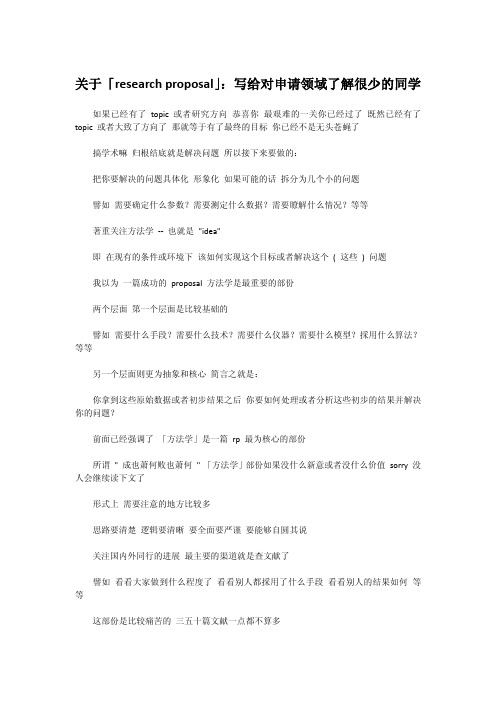
关于「research proposal」:写给对申请领域了解很少的同学如果已经有了topic 或者研究方向恭喜你最艰难的一关你已经过了既然已经有了topic 或者大致了方向了那就等于有了最终的目标你已经不是无头苍蝇了搞学术嘛归根结底就是解决问题所以接下来要做的:把你要解决的问题具体化形象化如果可能的话拆分为几个小的问题譬如需要确定什么参数?需要测定什么数据?需要瞭解什么情况?等等著重关注方法学-- 也就是"idea"即在现有的条件或环境下该如何实现这个目标或者解决这个( 这些) 问题我以为一篇成功的proposal 方法学是最重要的部份两个层面第一个层面是比较基础的譬如需要什么手段?需要什么技术?需要什么仪器?需要什么模型?採用什么算法?等等另一个层面则更为抽象和核心简言之就是:你拿到这些原始数据或者初步结果之后你要如何处理或者分析这些初步的结果并解决你的问题?前面已经强调了「方法学」是一篇rp 最为核心的部份所谓" 成也萧何败也萧何" 「方法学」部份如果没什么新意或者没什么价值sorry 没人会继续读下文了形式上需要注意的地方比较多思路要清楚逻辑要清晰要全面要严谨要能够自圆其说关注国内外同行的进展最主要的渠道就是查文献了譬如看看大家做到什么程度了看看别人都採用了什么手段看看别人的结果如何等等这部份是比较痛苦的三五十篇文献一点都不算多先列一个outline 出来我个人的rp 大致分为如下基本部份:背景介绍- 文献综述- 研究目的- 研究方法- ( 预期结果) - 展望- 参考文献列表「文献综述」基本上就是「我们目前对这个问题瞭解到什么程度了」「研究目的」基本上就是「我想解决什么问题」显然这个是核心所在「研究方法」顾名思义就是「我们想通过何种途径来解决这个问题」整体的逻辑大该是:基于我们目前的知识我们还需要解决什么问题以及我们该如何解决这个问题接下来就照著outline 动手写吧需要注意的问题:结构清晰思路清楚切忌罗嗦而且要有可操作性比如你的研究需要太过昂贵的或者过分尖端的仪器或者技术你就需要思考一下可行性了而且很重要的一点说话不能空口无凭要有凭有据!譬如某个观点是别人的研究里得出来的那麽一定要列出来出处或者某个观点是你总结归纳出来的那麽论据要充分或者某个观点是基于未发表的结果那麽也要标注来源或出处如是坦言我个人并不擅长写作经验有一点点但也不多我个人觉得理工类科技类的写作( 譬如受众多为专业人士的论文专著等) 并不刻意追求表达方面的艺术性但是在文字或表述上有其特殊的要求这裡基于个人的一些经历和体会强调一点即:逻辑清晰表述严谨这一点非常重要譬如" 因为我肚子饿了所以我要喝水" 显然这个论点和论据并无直接的联繫或者说从论据无法推理得到该结论这个例子很夸张很荒谬但是这类问题发生的概率非常之高归结一下常见的容易被直接枪毙的错误有:( 1 ) 混淆了" 回归( regression ) " 与" 相关( correlation ) " 之间的区别;( 2 ) 由表观上的" 相关关系" 仓促给出" 因果关系"。
research proposal 完整结构

research proposal 完整结构首先,需要明确研究的主题,即中括号内的内容,以便在文章中进行深入探讨。
接下来,可以按照下述的结构,逐步回答问题。
1. 引言部分(Introduction)- 文章开头需要提出研究的背景和目的,引起读者的兴趣。
- 解释为什么研究主题重要,并提出研究问题。
2. 文献综述(Literature Review)- 对该主题已有的研究进行全面的评估和整理,确定研究的基础。
- 介绍相关理论,解释已有研究结果,以及可能存在的研究空白。
3. 研究问题与目标(Research Question and Objectives)- 提出明确的研究问题,以及希望通过该研究实现的目标。
- 阐述为什么研究该问题,有助于扩充现有知识。
4. 研究方法(Research Methodology)- 描述用于回答研究问题的研究方法(如调查、实验、文献分析等)。
- 理论上合理选择的研究方法,并解释为何选择这些方法。
5. 数据收集与分析(Data Collection and Analysis)- 说明数据来源和采集方法,以及数据或样本的质量保证措施。
- 描述数据分析方法,可使用统计工具或质性分析方法。
6. 预期结果与推论(Expected Results and Implications)- 阐述希望获得的结果,并解释结果对理论、政策或实践的影响。
- 讨论可能存在的不确定性,并提供解决不确定性的方法。
7. 讨论与结论(Discussion and Conclusion)- 对研究结果进行全面分析和讨论,与前述文献综述进行对比。
- 总结研究结果,回答研究问题,并提出对未来研究的建议。
8. 参考文献(References)- 列出所有在文章中引用过的文献,格式应符合规定的引用风格。
最后,需要注意保持文章的逻辑和条理性,并保证所提供的信息充分支持研究主题。
另外,文章中应有适当的图表、统计数据或示例来支持分析和讨论。
phd research proposal translation studies -回复
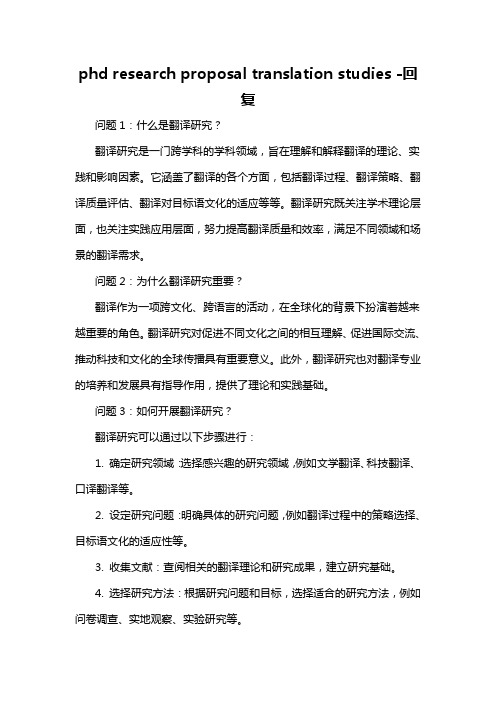
phd research proposal translation studies -回复问题1:什么是翻译研究?翻译研究是一门跨学科的学科领域,旨在理解和解释翻译的理论、实践和影响因素。
它涵盖了翻译的各个方面,包括翻译过程、翻译策略、翻译质量评估、翻译对目标语文化的适应等等。
翻译研究既关注学术理论层面,也关注实践应用层面,努力提高翻译质量和效率,满足不同领域和场景的翻译需求。
问题2:为什么翻译研究重要?翻译作为一项跨文化、跨语言的活动,在全球化的背景下扮演着越来越重要的角色。
翻译研究对促进不同文化之间的相互理解、促进国际交流、推动科技和文化的全球传播具有重要意义。
此外,翻译研究也对翻译专业的培养和发展具有指导作用,提供了理论和实践基础。
问题3:如何开展翻译研究?翻译研究可以通过以下步骤进行:1. 确定研究领域:选择感兴趣的研究领域,例如文学翻译、科技翻译、口译翻译等。
2. 设定研究问题:明确具体的研究问题,例如翻译过程中的策略选择、目标语文化的适应性等。
3. 收集文献:查阅相关的翻译理论和研究成果,建立研究基础。
4. 选择研究方法:根据研究问题和目标,选择适合的研究方法,例如问卷调查、实地观察、实验研究等。
5. 执行研究:按照研究设计和方法进行数据收集和分析。
6. 解释结果:根据研究结果,解释和分析翻译现象,提出理论和实践意义。
7. 撰写论文:将研究结果整理成学术论文,包括引言、文献综述、研究方法、数据结果、讨论和结论等部分。
8. 发表与交流:将研究成果发表在学术期刊上,参加国际学术会议等,与其他研究者交流和分享成果。
问题4:有哪些热门研究课题可以从事?翻译研究涉及广泛,以下是一些热门研究课题供参考:1. 翻译策略:研究不同翻译策略对翻译效果的影响,如直译与意译的对比。
2. 跨文化适应:探究翻译在不同文化背景下的适应性,以及文化差异对翻译的影响。
3. 语言变体处理:研究不同语言变体(如方言、地区差异)在翻译中的应对策略。
phd research proposal translation studies -回复

phd research proposal translation studies -回复与研究主题相关的问题。
题目:翻译研究博士研究课题翻译研究导言:在全球化的背景下,翻译的重要性变得愈发突出。
作为一种跨文化交流的工具,翻译在不同领域的影响力日益扩大。
然而,翻译研究仍然面临许多挑战,需要探索更加深入的理论和方法。
本文章将围绕翻译研究的主题展开探讨,从研究目的和背景入手,逐步回答与该课题相关的问题。
第一部分:研究目的和背景研究目的:本研究的目的是探讨翻译研究的重要性、挑战和前景,并尝试提出一种有效的研究方法和框架,以促进翻译研究的发展。
研究背景:随着全球化的加速发展,翻译在文化交流和跨领域合作中的作用不可忽视。
然而,传统的翻译研究仍然受到很多限制,包括对文本和语境的理解不足、不同翻译方法和策略的效果评估不足等。
此外,快速崛起的机器翻译技术也对翻译研究提出了新的挑战。
因此,为了更好地应对这些挑战并推动翻译研究的进一步发展,本研究将对当前的研究现状进行深入分析,并提出一种更加全面和系统的方法。
第二部分:研究问题研究问题1:翻译的重要性在不同领域中的具体体现是什么?通过对现有翻译案例的分析,本研究将探讨翻译在不同领域(如商业、文学、科学等)中的实际应用,以评估翻译在文化交流中的重要性和作用。
研究问题2:传统翻译研究存在的主要挑战是什么?通过对文献和研究进展的综述,本研究将分析传统翻译研究所面临的挑战,如文本和语境理解、不同翻译方法和策略的有效性等,并提出解决这些挑战的策略和方法。
研究问题3:机器翻译技术对翻译研究的影响是什么?通过对机器翻译技术的概述和分析,本研究将讨论机器翻译技术对翻译研究的影响,并探讨如何在研究中融合机器翻译技术以提高研究效率和准确性。
第三部分:研究方法和框架方法1:案例研究本研究将采用案例研究方法,通过对现有翻译案例的具体分析,探讨翻译在不同领域中的实际应用,从而评估翻译的重要性和作用。
英文research proposal格式
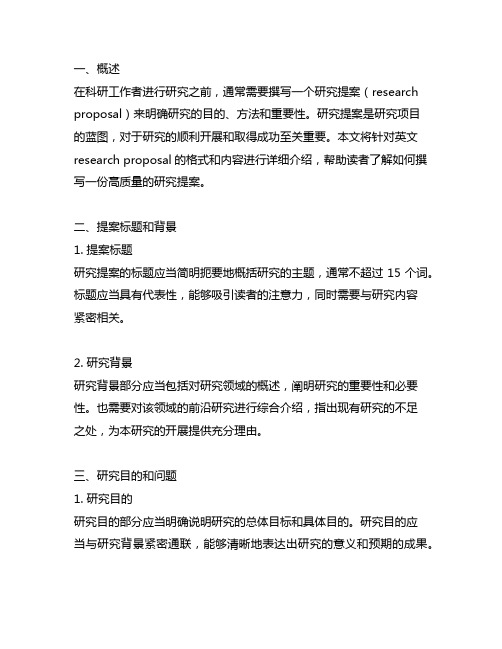
一、概述在科研工作者进行研究之前,通常需要撰写一个研究提案(research proposal)来明确研究的目的、方法和重要性。
研究提案是研究项目的蓝图,对于研究的顺利开展和取得成功至关重要。
本文将针对英文research proposal的格式和内容进行详细介绍,帮助读者了解如何撰写一份高质量的研究提案。
二、提案标题和背景1. 提案标题研究提案的标题应当简明扼要地概括研究的主题,通常不超过15个词。
标题应当具有代表性,能够吸引读者的注意力,同时需要与研究内容紧密相关。
2. 研究背景研究背景部分应当包括对研究领域的概述,阐明研究的重要性和必要性。
也需要对该领域的前沿研究进行综合介绍,指出现有研究的不足之处,为本研究的开展提供充分理由。
三、研究目的和问题1. 研究目的研究目的部分应当明确说明研究的总体目标和具体目的。
研究目的应当与研究背景紧密通联,能够清晰地表达出研究的意义和预期的成果。
2. 研究问题研究问题部分应当提出明确的研究问题或假设,阐明研究的内容和范围。
研究问题需要具有可操作性,既能够被具体的研究方法所解决,又能够对研究领域产生积极影响。
四、研究方法和流程1. 研究方法研究方法部分应当详细描述研究的具体方法和步骤,包括实验设计、数据采集和分析方法等。
研究方法需要符合科学规范和伦理要求,能够有效地解决研究问题,并得到可信的研究结果。
2. 研究流程研究流程部分应当对研究的具体进展和时间安排进行详细规划,包括各项工作的时间节点和人力物力的分配。
研究流程需要合理可行,能够保证研究的顺利开展和按时完成。
五、预期成果和意义1. 预期成果预期成果部分应当说明研究取得的具体成果和效益,可以是新的理论发现、实用技术或政策建议等。
预期成果需要与研究目的和问题相一致,能够对研究领域产生重要影响。
2. 研究意义研究意义部分应当阐明研究的社会和学术价值,可能涉及到对学科发展、社会进步或经济效益等方面的影响。
研究意义需要全面客观地评估,并表明研究的重要性和必要性。
研究计划-Research-Proposal-模板
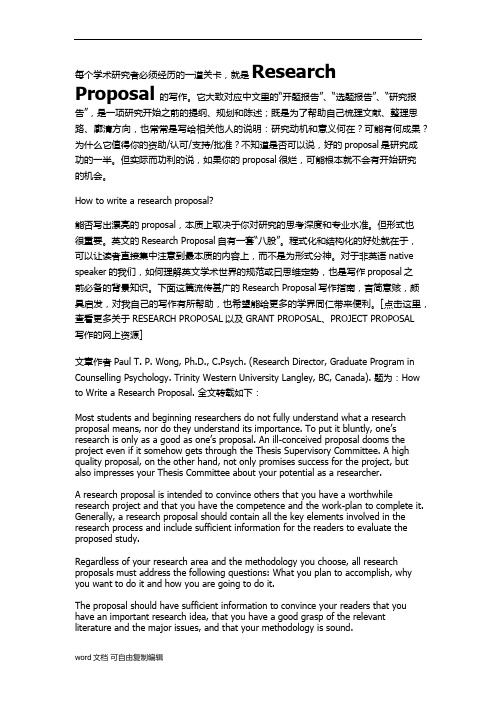
每个学术研究者必须经历的一道关卡,就是Research Proposal的写作。
它大致对应中文里的“开题报告”、“选题报告”、“研究报告”,是一项研究开始之前的提纲、规划和陈述;既是为了帮助自己梳理文献、整理思路、廓清方向,也常常是写给相关他人的说明:研究动机和意义何在?可能有何成果?为什么它值得你的资助/认可/支持/批准?不知道是否可以说,好的proposal是研究成功的一半。
但实际而功利的说,如果你的proposal很烂,可能根本就不会有开始研究的机会。
How to write a research proposal?能否写出漂亮的proposal,本质上取决于你对研究的思考深度和专业水准。
但形式也很重要。
英文的Research Proposal自有一套“八股”。
程式化和结构化的好处就在于,可以让读者直接集中注意到最本质的内容上,而不是为形式分神。
对于非英语native speaker的我们,如何理解英文学术世界的规范或曰思维定势,也是写作proposal之前必备的背景知识。
下面这篇流传甚广的Research Proposal写作指南,言简意赅,颇具启发,对我自己的写作有所帮助,也希望能给更多的学界同仁带来便利。
[点击这里,查看更多关于RESEARCH PROPOSAL以及GRANT PROPOSAL、PROJECT PROPOSAL写作的网上资源]文章作者Paul T. P. Wong, Ph.D., C.Psych. (Research Director, Graduate Program in Counselling Psychology. Trinity Western University Langley, BC, Canada). 题为:How to Write a Research Proposal. 全文转载如下:Most students and beginning researchers do not fully understand what a research proposal means, nor do they understand its importance. To put it bluntly, one’s research is only as a good as one’s proposal. An ill-conceived proposal dooms the project even if it somehow gets through the Thesis Supervisory Committee. A high quality proposal, on the other hand, not only promises success for the project, but also impresses your Thesis Committee about your potential as a researcher.A research proposal is intended to convince others that you have a worthwhile research project and that you have the competence and the work-plan to complete it. Generally, a research proposal should contain all the key elements involved in the research process and include sufficient information for the readers to evaluate the proposed study.Regardless of your research area and the methodology you choose, all research proposals must address the following questions: What you plan to accomplish, why you want to do it and how you are going to do it.The proposal should have sufficient information to convince your readers that you have an important research idea, that you have a good grasp of the relevant literature and the major issues, and that your methodology is sound.The quality of your research proposal depends not only on the quality of your proposed project, but also on the quality of your proposal writing. A good research project may run the risk of rejection simply because the proposal is poorly written. Therefore, it pays if your writing is coherent, clear and compelling.This paper focuses on proposal writing rather than on the development of research ideas.TITLE:It s hould be concise and descriptive. For example, the phrase, “An investigationof . . .” could be omitted. Often titles are stated in terms of a functional relationship, because such titles clearly indicate the independent and dependent variables. However, if possible, think of an informative but catchy title. An effective title not only pricks the reader’s interest, but also predisposes him/her favourably towards the proposal.ABSTRACT:It is a brief summary of approximately 300 words. It should include the research question, the rationale for the study, the hypothesis (if any), the method and the main findings. Descriptions of the method may include the design, procedures, the sample and any instruments that will be used.INTRODUCTION:The main purpose of the introduction is to provide the necessary background or context for your research problem. How to frame the research problem is perhaps the biggest problem in proposal writing.If the research problem is framed in the context of a general, rambling literature review, then the research question may appear trivial and uninteresting. However, if the same question is placed in the context of a very focused and current research area, its significance will become evident.Unfortunately, there are no hard and fast rules on how to frame your research question just as there is no prescription on how to write an interesting and informative opening paragraph. A lot depends on your creativity, your ability to think clearly and the depth of your understanding of problem areas.However, try to place your research question in the context of either a current “hot” area, or an older area that remains viable. Secondly, you need to provide a brief but appropriate historical backdrop. Thirdly, provide the contemporary context in which your proposed research question occupies the central stage. Finally, identify “key players” and refer to the most relevant and representative publications. In short, try to paint your research question in broad brushes and at the same time bring out its significance.The introduction typically begins with a general statement of the problem area, with a focus on a specific research problem, to be followed by the rational or justification for the proposed study. The introduction generally covers the following elements:1. State the research problem, which is often referred to as the purpose of the study.2. Provide the context and set the stage for your research question in such a way as to show its necessity and importance.3. Present the rationale of your proposed study and clearly indicate why it is worth doing.4. Briefly describe the major issues and sub-problems to be addressed by your research.5. Identify the key independent and dependent variables of your experiment. Alternatively, specify the phenomenon you want to study.6. State your hypothesis or theory, if any. For exploratory or phenomenological research, you may not have any hypotheses. (Please do not confuse the hypothesis with the statistical null hypothesis.)7. Set the delimitation or boundaries of your proposed research in order to provide a clear focus.8. Provide definitions of key concepts. (This is optional.)LITERATURE REVIEW:Sometimes the literature review is incorporated into the introduction section. However, most professors prefer a separate section, which allows a more thorough review of the literature.The literature review serves several important functions:1. Ensures that you are not “reinventing the wheel”.2. Gives credits to those who have laid the groundwork for your research.3. Demonstrates your knowledge of the research problem.4. Demonstrates your understanding of the theoretical and research issues related to your research question.5. Shows your ability to critically evaluate relevant literature information.6. Indicates your ability to integrate and synthesize the existing literature.7. Provides new theoretical insights or develops a new model as the conceptual framework for your research.8. Convinces your reader that your proposed research will make a significant and substantial contribution to the literature (i.e., resolving an important theoretical issue or filling a major gap in the literature).Most students’ literature reviews suffer from the following problems:* Lacking organization and structure* Lacking focus, unity and coherence* Being repetitive and verbose* Failing to cite influential papers* Failing to keep up with recent developments* Failing to critically evaluate cited papers* Citing irrelevant or trivial references* Depending too much on secondary sourcesYour scholarship and research competence will be questioned if any of the above applies to your proposal.There are different ways to organize your literature review. Make use of subheadings to bring order and coherence to your review. For example, having established the importance of your research area and its current state of development, you may devote several subsections on related issues as: theoretical models, measuring instruments, cross-cultural and gender differences, etc.It is also helpful to keep in mind that you are telling a story to an audience. Try totell it in a stimulating and engaging manner. Do not bore them, because it may lead to rejection of your worthy proposal. (Remember: Professors and scientists are human beings too.)METHODS:The Method section is very important because it tells your Research Committee how you plan to tackle your research problem. It will provide your work plan and describe the activities necessary for the completion of your project.The guiding principle for writing the Method section is that it should contain sufficient information for the reader to determine whether methodology is sound. Some even argue that a good proposal should contain sufficient details for another qualified researcher to implement the study.You need to demonstrate your knowledge of alternative methods and make the case that your approach is the most appropriate and most valid way to address your research question.Please note that your research question may be best answered by qualitative research. However, since most mainstream psychologists are still biased against qualitative research, especially the phenomenological variety, you may need to justify your qualitative method.Furthermore, since there are no well-established and widely accepted canons in qualitative analysis, your method section needs to be more elaborate than what is required for traditional quantitative research. More importantly, the data collection process in qualitative research has a far greater impact on the results as comparedto quantitative research. That is another reason for greater care in describing how you will collect and analyze your data. (How to write the Method section for qualitative research is a topic for another paper.)For quantitative studies, the method section typically consists of the following sections:1. Design -Is it a questionnaire study or a laboratory experiment? What kind of design do you choose?2. Subjects or participants – Who will take part in your study ? What kind of sampling procedure do you use?3. Instruments – What kind of measuring instruments or questionnaires do you use? Why do you choose them? Are they valid and reliable?4. Procedure – How do you plan to carry out your study? What activities are involved? How long does it take?RESULTS:Obviously you do not have results at the proposal stage. However, you need to have some idea about what kind of data you will be collecting, and what statistical procedures will be used in order to answer your research question or test you hypothesis.DISCUSSION:It is important to convince your reader of the potential impact of your proposed research. You need to communicate a sense of enthusiasm and confidence without exaggerating the merits of your proposal. That is why you also need to mention the limitations and weaknesses of the proposed research, which may be justified by time and financial constraints as well as by the early developmental stage of your research area.Common Mistakes in Proposal Writing1. Failure to provide the proper context to frame the research question.2. Failure to delimit the boundary conditions for your research.3. Failure to cite landmark studies.4. Failure to accurately present the theoretical and empirical contributions by other researchers.5. Failure to stay focused on the research question.6. Failure to develop a coherent and persuasive argument for the proposed research.7. Too much detail on minor issues, but not enough detail on major issues.8. Too much rambling —going “all over the map” without a clear sense of direction. (The best proposals move forward with ease and grace like a seamless river.)9. Too many citation lapses and incorrect references.10. Too long or too short.11. Failing to follow the APA style.12. Slopping writing./2008/02/25/762/大多数学生和刚起步的研究者都不了解什么是研究计划,也不知道其重要性。
翻译研究报告开题报告

翻译研究报告开题报告Translation Research Report Proposal翻译研究报告开题报告1. IntroductionThis research proposal aims to investigate the translation strategies employed in translating literary works from English to Chinese. As translation plays a significant role in cross-cultural communication, it is important to understand the various approaches used by translators to convey the essence and style of original literary texts. This research will contribute to the existing body of knowledge in translation studies and provide insight into the field of literary translation.2. Research ObjectivesThe main objectives of this research are as follows:- To examine the different translation strategies used in translating literary works from English to Chinese.- To analyze the impact of translation strategies on the quality and effectiveness of the translated texts.- To investigate the challenges faced by translators in conveying the cultural and stylistic elements of literary texts.- To propose recommendations for translators to enhance the translation of literary works.3. MethodologyThis research will be conducted through a combination of qualitative and quantitative analysis. A sample of translated literary texts from English to Chinese will be selected for analysis.The texts will be analyzed using content analysis to identify the translation strategies employed. Additionally, interviews will be conducted with experienced translators to gain insights into their decision-making process when translating literary texts.4. Expected ResultsIt is expected that this research will reveal a variety of translation strategies used in translating literary works and provide a comprehensive understanding of their impact on the quality of the translated texts. The findings will also shed light on the challenges faced by translators and propose recommendations for improving the translation process.5. Significance of the StudyThis research is significant as it contributes to the field of translation studies and specifically focuses on the translation of literary works. By understanding the strategies employed by translators, it will be possible to improve the quality and effectiveness of literary translation. Additionally, this research will provide valuable insights for translators facing challenges in conveying cultural and stylistic elements in translated texts.6. ConclusionThis research proposal outlines a study on the translation strategies employed in translating literary works from English to Chinese. By investigating the various approaches used by translators, this research aims to enhance the understanding of literary translation and provide recommendations for improving the quality and effectiveness of translated texts.。
如何写作Research Proposal(译文)

/view/460a9c104431b90d6c85c717.html许多学生和刚入门的研究者无法去充分理解研究计划的意义和重要性。
坦率的说,一个人的研究不会比计划做得更好。
所有构思拙劣的计划一开始就决定了研究的不好情况,即使能够通过学术委员会的。
另一方面,一个高质量的论文计划不但可以保证研究计划的成功,还能给学术委员会留下你具有研究潜能的印象。
研究规划可以告诉别人你有一个有价值的研究工程并且你有能力和计划完成这个规划,一般而言,研究规划应该包括研究过程中的所有重点内容,并且有足够的信息让读者评判要进行的研究。
不管你选择什么样的研究领域和方法,所有的研究规划必须包括以下内容:计划做什么?为什么做此选择?还有如何去做?规划应该包括足够的信息去说服读者,你有一个非常重要的研究规划。
你对相关领域和主要课题的提出了解决方案,并且你的方法是合理的。
规划质量不仅取决于规划的计划,还取决于规划的写作。
因为拙劣的写作,一个好的研究规划可能会被否定掉。
因此,把规划的写的连贯、清晰、有说服力就变得极有价值。
这篇文章专注于规划的写作,而不是研究方案的进展。
题目:题目应当有说服力并且形象生动。
比如:词组“对...的描述”可以省略,题目通常基于一种功能关系,因为这种题目清晰给出了自变量和因变量。
可能的情况下,构思出信息性强同时琅琅上口的题目。
一个好的题目不仅能激发起读者的兴趣,还能让他/她找到自己最感兴趣的部分。
摘要:这是一段大约300字的简洁摘要,应当包括研究问题,问题的合理性,假设(如果可能的话),方法和主要的发现。
方法的描述包括设计、过程、样品和任何用到的样品。
介绍:介绍的目的是提供研究问题的必要背景和内容。
如何定位问题可能是写作过程中最重要的部分。
如果研究的问题在普通杂乱的语境中列出的话,问题会显得琐碎、没有吸引人之处。
同样的问题如果用集中紧凑的格式列出,他的意义就会很明显。
不幸的是没有硬性快速的规则告诉你如何构思研究课题,因为没有关于如何写出有趣并且信息开放的段落。
翻译研究方法Research Proposal
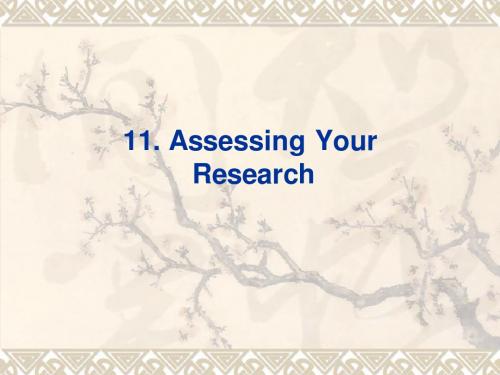
11.1 Self-assessment
Here is a checklist of the kinds of purely methodological issues you might want to assess in your own work:
Research question / aim
Follow-up
Now what? Have you made some suggestions?
Implications
So what? Have you considered these, in the conclusion?
11.2 Internal Assessment
The key question is: are the readers convinced by what you are telling them? Behind this question there lie various assumptions. Readers are more likely to feel impressed if:
Material
Have you presented your empirical material clearly? Have you explained why you chose it? How relevant is it to your research question? Have you explained how you collected it? How representative is it?
11.4 Typical Weaknesses
The following are the kinds of things that referees draw attention to when recommending, or in fact not recommending, that something be published:
research proposal英文解释
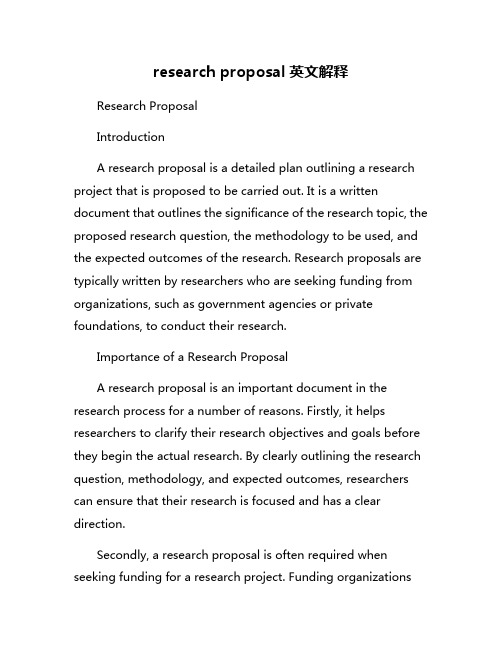
research proposal英文解释Research ProposalIntroductionA research proposal is a detailed plan outlining a research project that is proposed to be carried out. It is a written document that outlines the significance of the research topic, the proposed research question, the methodology to be used, and the expected outcomes of the research. Research proposals are typically written by researchers who are seeking funding from organizations, such as government agencies or private foundations, to conduct their research.Importance of a Research ProposalA research proposal is an important document in the research process for a number of reasons. Firstly, it helps researchers to clarify their research objectives and goals before they begin the actual research. By clearly outlining the research question, methodology, and expected outcomes, researchers can ensure that their research is focused and has a clear direction.Secondly, a research proposal is often required when seeking funding for a research project. Funding organizationsuse research proposals to evaluate the feasibility and importance of a proposed research project. A well-written research proposal can increase the chances of securing funding for a research project.Components of a Research ProposalA research proposal typically includes several key components that provide an overview of the proposed research project. These components may vary depending on the requirements of the funding organization, but generally include the following:1. Title: The title of the research proposal should be clear, concise, and descriptive of the research topic.2. Abstract: The abstract provides a summary of the research proposal, including the research question, methodology, and expected outcomes.3. Introduction: The introduction provides background information on the research topic, explains why the research is important, and outlines the research question.4. Literature Review: The literature review examines previous research on the topic and explains how the proposed research will contribute to the existing body of knowledge.5. Research Methodology: The methodology section outlines the research design, data collection methods, and data analysis techniques that will be used in the research project.6. Expected Outcomes: The expected outcomes section describes the potential results of the research project and how these results will contribute to the field.7. Timeline: The timeline outlines the proposed schedule for the research project, including key milestones and deadlines.8. Budget: The budget section provides an estimate of the costs associated with the research project, including personnel, equipment, and other expenses.ConclusionIn conclusion, a research proposal is a key document in the research process that outlines the proposed research project in detail. It helps researchers to clarify their research objectives, secure funding for their research, and ensure that their research is focused and well-planned. By including key components such as the research question, methodology, and expected outcomes, researchers can increase the chances of success in their research projects.。
phd research proposal translation studies -回复
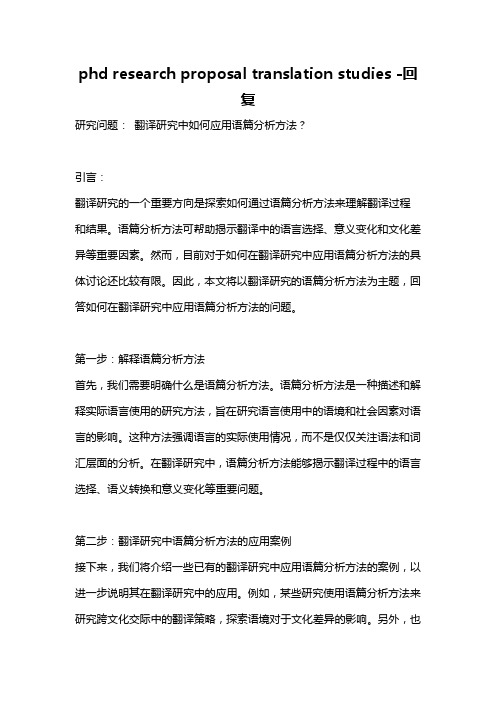
phd research proposal translation studies -回复研究问题:翻译研究中如何应用语篇分析方法?引言:翻译研究的一个重要方向是探索如何通过语篇分析方法来理解翻译过程和结果。
语篇分析方法可帮助揭示翻译中的语言选择、意义变化和文化差异等重要因素。
然而,目前对于如何在翻译研究中应用语篇分析方法的具体讨论还比较有限。
因此,本文将以翻译研究的语篇分析方法为主题,回答如何在翻译研究中应用语篇分析方法的问题。
第一步:解释语篇分析方法首先,我们需要明确什么是语篇分析方法。
语篇分析方法是一种描述和解释实际语言使用的研究方法,旨在研究语言使用中的语境和社会因素对语言的影响。
这种方法强调语言的实际使用情况,而不是仅仅关注语法和词汇层面的分析。
在翻译研究中,语篇分析方法能够揭示翻译过程中的语言选择、语义转换和意义变化等重要问题。
第二步:翻译研究中语篇分析方法的应用案例接下来,我们将介绍一些已有的翻译研究中应用语篇分析方法的案例,以进一步说明其在翻译研究中的应用。
例如,某些研究使用语篇分析方法来研究跨文化交际中的翻译策略,探索语境对于文化差异的影响。
另外,也有研究采用语篇分析方法分析翻译过程中的语义转换,详细考察不同语境下的意义变化。
这些研究显示了语篇分析方法在揭示翻译中的重要问题方面的潜力。
第三步:研究框架的构建在第三步中,本文将提出一个研究框架,以帮助研究人员在翻译研究中应用语篇分析方法。
该研究框架包含以下几个关键方面:首先,确定研究目标,即明确研究想要回答的问题。
其次,选择适当的语篇理论和分析方法,以满足研究目标。
不同的研究目标可能需要不同的语篇理论和分析方法,因此研究人员需要在选择时慎重考虑。
最后,进行实证研究,即根据选定的理论和方法,分析实际的翻译案例以回答研究问题。
通过这一研究框架,研究人员可以有针对性地应用语篇分析方法来解决翻译研究中的相关问题。
结论:本文通过逐步回答如何在翻译研究中应用语篇分析方法的问题,帮助读者了解并掌握在翻译研究中使用语篇分析方法的基本原理和实践方法。
phd research proposal translation studies -回复
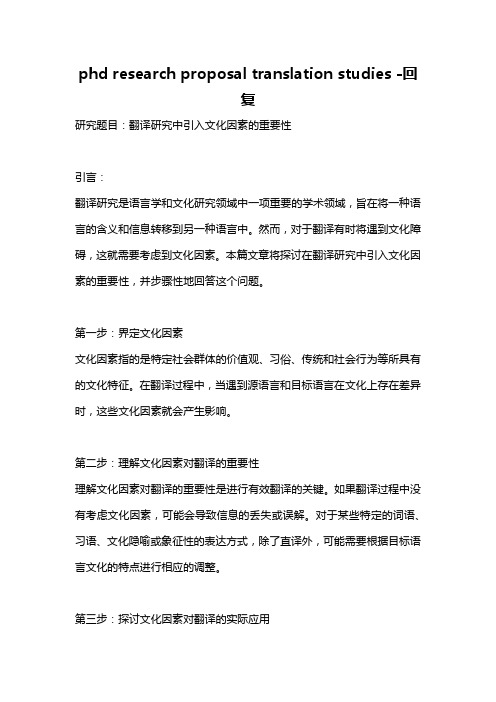
phd research proposal translation studies -回复研究题目:翻译研究中引入文化因素的重要性引言:翻译研究是语言学和文化研究领域中一项重要的学术领域,旨在将一种语言的含义和信息转移到另一种语言中。
然而,对于翻译有时将遇到文化障碍,这就需要考虑到文化因素。
本篇文章将探讨在翻译研究中引入文化因素的重要性,并步骤性地回答这个问题。
第一步:界定文化因素文化因素指的是特定社会群体的价值观、习俗、传统和社会行为等所具有的文化特征。
在翻译过程中,当遇到源语言和目标语言在文化上存在差异时,这些文化因素就会产生影响。
第二步:理解文化因素对翻译的重要性理解文化因素对翻译的重要性是进行有效翻译的关键。
如果翻译过程中没有考虑文化因素,可能会导致信息的丢失或误解。
对于某些特定的词语、习语、文化隐喻或象征性的表达方式,除了直译外,可能需要根据目标语言文化的特点进行相应的调整。
第三步:探讨文化因素对翻译的实际应用探讨文化因素对于翻译的实际应用是为了深入了解如何在翻译过程中引入文化因素。
这可以通过以下几个方面实现:1. 对源语言进行文化分析:在翻译之前,首先要对源语言文化进行分析,理解其中的文化特点。
这将有助于翻译者理解原文中可能存在的文化因素,以及它们与其他文化的差异。
2. 对目标语言进行文化分析:同样重要的是对目标语言文化进行分析。
这包括了解目标语言文化中的价值观、习俗和传统等,以便在翻译中进行相应调整。
3. 选择合适的翻译策略:不同的文化因素可能需要不同的翻译策略。
对于某些文化特有的词语或表达方式,直接翻译可能无法完全传达其意义,因此需要采用类比、解释或注解等翻译策略。
4. 进行文化适应和再现:在翻译过程中,翻译者需要力求保持源语言文化的独特性,并在目标语言中再现其相应的文化含义。
这要求翻译者具备跨文化沟通的能力,将文化因素合理地引入翻译过程中。
结论:本文探讨了翻译研究中引入文化因素的重要性。
- 1、下载文档前请自行甄别文档内容的完整性,平台不提供额外的编辑、内容补充、找答案等附加服务。
- 2、"仅部分预览"的文档,不可在线预览部分如存在完整性等问题,可反馈申请退款(可完整预览的文档不适用该条件!)。
- 3、如文档侵犯您的权益,请联系客服反馈,我们会尽快为您处理(人工客服工作时间:9:00-18:30)。
Other relevant research
How well did you relate what you are doing to what others have done? Have you consulted the most relevant sources?
Length
The main reasons for excessive length seem to be: • Topic too wide • Irrelevance • Repetition • Banalities
Organization
Organization may be unclear, or illogical. Whether the work lacks an overall awareness of what the point of the whole thing is; How the various sections fit together into a coherent whole.
Hypothesis
Are you starting or concluding with a specific hypothesis? Did you make this clear? What kind of hypothesis is it? Why is it interesting / important? Is it well justified?
Justification of topic, interest, relevance; Definition of problem, basic hypothesis, aims; Awareness and critical presentation of other relevant research; Choice and justification of theoretical framework; Presentation and justification of methodology; Presentation and justification of data;
Lack of a critical attitude
11.1 Self-assessment
Here is a checklist of the kinds of purely methodological issues you might want to assess in your own work:
Research question / aim
Reliability
Is the analysis reliable? Is it explicit enough to be replicable? Are the calculations accurate? Are the classifications consistent? Are the statistics appropriate?
Theoretical model
Have you explained why you chose a particular theoretical model or approach / a particular variant of that model? What about other possibilities? Did you explain why you rejected those? Have you adapted the model at all? Why?
Relation between variables
What kind of relation are you looking for? Do you think you have found any relation? Between what variables is the relation you have found? Is this clear to the reader?
Review of the literature
The writer neglects some major relevant sources; The writer is uncritical of the sources used; He/she relies very heavily on one or two sources only, giving a biased picture of what others have done.
11.4 Typical Weaknesses
The following are the kinds of things that referees draw attention to when recommending, or in fact not recommending, that something be published:
Follow-up
Now what? Have you made some suggestions?
Implications
So what? Have you considered these, in the conclusion?
11.2 Internal Assessment
The key question is: are the readers convinced by what you are telling them? Behind this question there lie various assumptions. Readers are more likely to feel impressed if:
A version of the internal assessment
To illustrate how these assumptions appear in assessment criteria, here is a version of the assessment when reading and grading MA theses. As teachers read, they usually take notes under each of these headings:
Analysis and discussion of results, use of evidence, logic; Validity of conclusions, self-critical awareness of the work’s strengths and weaknesses; Overall structure, stylistic aspects, academic conventions, clarity; Originality, wider implications, significance.
General concepts and categories
Are they adequately defined? Are they justified against alternative concepts, categories and definitions? What kind of categories? What kind of classification? Have you been explicit enough in presenting these?
Material
Have you presented your empirical material clearly? Have you explained why you chose it? How relevant is it to your research question? Have you explained how you collected it? How representative is it?
Validity
Are the conclusions valid? Are the hypotheses supported or not? Is there adequate evidence? Is the argument logical? Is the evidence relevant to the original research problem? Do the conclusions line up with the introduction and the stated aim?
Methodology
Lack of explicitness
The topic question (the aim) is too vague; Crucial terms are not explicitly defined; Necessary information about the material or method of analysis is missing.
Lack ofΒιβλιοθήκη evidenceClaims are made with no evidence to back them up, so that they appear to be purely subjective. Conclusions are not justified by the analysis. There is simply not enough data to support the generalizations that are proposed.
Counter-evidence
Have you considered any counter-evidence? Have you dealt with borderline cases adequately? Are there any counter-arguments? Are there any alternative explanations?
